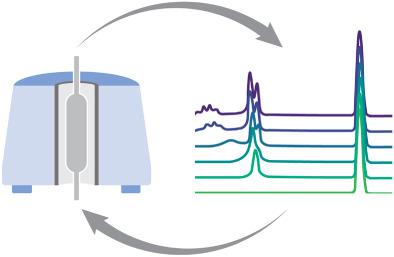当前位置:
X-MOL 学术
›
Magn. Reson. Chem.
›
论文详情
Our official English website, www.x-mol.net, welcomes your feedback! (Note: you will need to create a separate account there.)
Exploration of continuous-flow benchtop NMR acquisition parameters and considerations for reaction monitoring
Magnetic Resonance in Chemistry ( IF 2 ) Pub Date : 2020-09-07 , DOI: 10.1002/mrc.5094 Tristan Maschmeyer 1 , Paloma L Prieto 1 , Shad Grunert 1 , Jason E Hein 1
Magnetic Resonance in Chemistry ( IF 2 ) Pub Date : 2020-09-07 , DOI: 10.1002/mrc.5094 Tristan Maschmeyer 1 , Paloma L Prieto 1 , Shad Grunert 1 , Jason E Hein 1
Affiliation

|
This study focused on fundamental data acquisition parameter selection for a benchtop NMR system with continuous flow, applicable for reaction monitoring. The effect of flow rate on the mixing behaviours within a flow cell was observed, along with an exponential decay relationship between flow rate and the apparent spin-lattice relaxation time (T1*) of benzaldehyde. We also monitored sensitivity (as determined by signal-to-noise ratios, SNRs) under various flow rates, analyte concentrations, and temperatures of the analyte flask. Results suggest a maximum SNR can be achieved with low to medium flow rates and higher analyte concentrations. This was consistent with data collected with parameters that promote either slow or fast data acquisition. We further consider the effect of these conditions on the analyte's residence time, T1*, and magnetic field inhomogeneity that is a product of continuous flow. Altogether, our results demonstrate how fundamental acquisition parameters can be manipulated to achieve optimal data acquisition in continuous flow NMR systems.
中文翻译:

连续流台式核磁共振采集参数的探索和反应监测的注意事项
本研究侧重于连续流台式 NMR 系统的基本数据采集参数选择,适用于反应监测。观察到流速对流动池内混合行为的影响,以及流速与苯甲醛的表观自旋晶格弛豫时间 (T1*) 之间的指数衰减关系。我们还监测了不同流速、分析物浓度和分析物烧瓶温度下的灵敏度(由信噪比、SNR 确定)。结果表明,使用中低流速和较高的分析物浓度可以获得最大的 SNR。这与使用促进慢速或快速数据采集的参数收集的数据一致。我们进一步考虑了这些条件对分析物停留时间 T1* 的影响,磁场不均匀性是连续流动的产物。总而言之,我们的结果展示了如何操纵基本采集参数以在连续流 NMR 系统中实现最佳数据采集。
更新日期:2020-09-07
中文翻译:

连续流台式核磁共振采集参数的探索和反应监测的注意事项
本研究侧重于连续流台式 NMR 系统的基本数据采集参数选择,适用于反应监测。观察到流速对流动池内混合行为的影响,以及流速与苯甲醛的表观自旋晶格弛豫时间 (T1*) 之间的指数衰减关系。我们还监测了不同流速、分析物浓度和分析物烧瓶温度下的灵敏度(由信噪比、SNR 确定)。结果表明,使用中低流速和较高的分析物浓度可以获得最大的 SNR。这与使用促进慢速或快速数据采集的参数收集的数据一致。我们进一步考虑了这些条件对分析物停留时间 T1* 的影响,磁场不均匀性是连续流动的产物。总而言之,我们的结果展示了如何操纵基本采集参数以在连续流 NMR 系统中实现最佳数据采集。



























 京公网安备 11010802027423号
京公网安备 11010802027423号